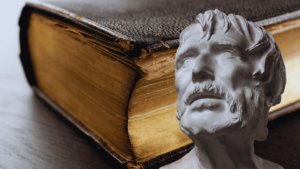In a world where change is the only constant, the ancient philosophy of Stoicism emerges as a beacon of resilience, offering timeless wisdom for modern challenges. Originating in the bustling markets of early 3rd century BC Athens, Stoicism was founded by Zeno of Citium. It quickly evolved into a practical guide for living, emphasizing virtue, tolerance, and self-control. Today, Stoicism’s principles continue to resonate, providing solace and strength to those navigating the complexities of contemporary life.
At the heart of Stoicism lies the concept of resilience – the ability to withstand, adapt to, and recover from adversity. In Stoic thought, resilience isn’t just about enduring hardship; it’s about transforming challenges into opportunities for personal growth and inner peace. This philosophy teaches that while we cannot always control external events, we can control our reactions and attitudes towards them. Thus, resilience in Stoicism is as much about emotional fortitude as it is about enduring tough times.
In this exploration of resilience through Stoic eyes, we will delve into the lives and teachings of some of the most prominent Stoic philosophers – Seneca, Epictetus, and Marcus Aurelius. Each of these figures not only preached the tenets of Stoicism but also lived them, their lives serving as compelling narratives of resilience in the face of overwhelming odds. From Seneca’s graceful handling of political turmoil to Epictetus’s journey from slavery to esteemed philosopher, and Marcus Aurelius’s reign as a philosopher-king amidst war and plague, their stories are as inspiring as they are instructive.
As we journey through these remarkable examples of Stoic resilience, we invite you to reflect on their relevance in your own life. How can the stoic mindset help you navigate the challenges you face today? What lessons can be drawn from these ancient stories to help foster your own resilience? Join us as we uncover the enduring legacy of Stoicism and its profound impact on the art of living bravely and with unwavering spirit.
Certainly! Here’s a draft for the “Historical Background of Stoicism” section of your blog article:
Historical Background of Stoicism
Stoicism, a school of Hellenistic philosophy, was born in the vibrant heart of Athens around 300 BC. It was founded by Zeno of Citium, a merchant turned philosopher after a shipwreck left him stranded in Athens. Inspired by the teachings of Socrates and the Cynics, Zeno began teaching in the Stoa Poikile, or Painted Porch, from which Stoicism derives its name.
The philosophy of Stoicism gained prominence through the works and lives of its key proponents. Seneca, a Roman statesman and playwright, provided practical guidance on ethical living. Epictetus, born into slavery, later became a revered teacher, emphasizing Stoicism as a way of life rather than mere theory. Marcus Aurelius, a Roman emperor, embodied Stoic principles in governance, and his personal writings, “Meditations,” offer a window into his private reflections on Stoic philosophy.
Stoicism is anchored in the belief that living in harmony with nature and accepting what we cannot control leads to a virtuous and resilient life. This philosophy identifies four cardinal virtues: wisdom, courage, justice, and temperance. Stoicism teaches that external events are beyond our control, but we can control our perceptions and reactions, thereby cultivating an inner resilience.
Resilience in Stoicism is about more than just enduring hardships; it’s about thriving through them. Stoics believe that challenges are opportunities to practice virtues. Adversity tests and strengthens resilience, as seen in the Stoic mantra: “What stands in the way becomes the way.” This mindset encourages a proactive approach to life’s obstacles, transforming them into lessons for personal growth.
Furthermore, Stoicism promotes the idea of ‘amor fati’ or ‘love of fate.’ This principle encourages embracing everything that happens, including suffering and loss, as necessary parts of the universe and our experience within it. By accepting and even welcoming the trials of life, Stoics develop a profound resilience that allows them to navigate life with equanimity and poise.
In summary, Stoicism, with its rich history and profound teachings, offers timeless insights into the art of resilience. The lives and works of its key philosophers – Zeno, Seneca, Epictetus, and Marcus Aurelius – not only provide a blueprint for enduring life’s vicissitudes but also for flourishing amidst them.
Case Study 1: Seneca
Lucius Annaeus Seneca, known simply as Seneca, was a figure who epitomized the Stoic virtues of resilience and fortitude amidst life’s turbulences. Born around 4 BCE in Corduba, in what is now Spain, Seneca was raised in Rome, where he was educated in philosophy and rhetoric. His life was a tapestry of immense successes and profound adversities, making him an exemplary study in Stoic resilience.
Seneca served as an advisor to Emperor Nero, a role that brought him immense wealth and influence. However, his relationship with the mercurial emperor was fraught with danger. Seneca navigated the perilous waters of Roman politics with a calm demeanor, embodying the Stoic principle of maintaining inner peace despite external chaos. His resilience was most starkly tested when he was accused of conspiring against Nero, leading to his forced suicide in 65 AD. Seneca’s dignified acceptance of his fate, without panic or lament, stands as a powerful testament to his Stoic beliefs.
Throughout his life, Seneca faced numerous challenges, including exile to Corsica under Emperor Claudius and recurrent health issues. Despite these adversities, he remained steadfast in his philosophical pursuits, writing extensively on ethics, philosophy, and the nature of the human condition. His writings offer rich insights into the Stoic approach to resilience.
One of Seneca’s key lessons on resilience is the importance of mental preparation for adversity. He famously said, “We suffer more often in imagination than in reality.” This highlights the Stoic belief that it’s not the events themselves that disturb us, but our interpretation of them. Seneca advocated for a proactive approach to challenges, suggesting that contemplating and mentally rehearsing potential hardships can strengthen our ability to face them when they occur.
Seneca also emphasized the value of adaptability and acceptance. In his letters, he wrote, “A gem cannot be polished without friction, nor a man perfected without trials.” This metaphor beautifully encapsulates the Stoic view that challenges and difficulties are opportunities for personal growth and refinement.
In conclusion, Seneca’s life and teachings offer a profound exploration of resilience from a Stoic perspective. His ability to maintain composure and purpose in the face of daunting challenges, his insights into the nature of suffering and adversity, and his counsel on preparing for and embracing life’s inevitable hardships remain as relevant today as they were in ancient Rome.
Case Study 2: Epictetus
Epictetus, a stoic philosopher of the first century AD, presents one of the most compelling narratives of resilience in the face of extreme adversity. Born into slavery in Hierapolis, Phrygia, Epictetus spent his early life in Rome, serving his master Epaphroditos, a wealthy freedman and secretary to Emperor Nero. Despite the constraints of his enslaved status, Epictetus was allowed to study philosophy, an opportunity that laid the foundation for his later teachings.
The resilience of Epictetus is strikingly evident in how he dealt with his circumstances. While still a slave, he embraced the Stoic philosophy that external conditions could not impede the freedom of one’s soul. After gaining his freedom, he began teaching philosophy in Rome until Emperor Domitian banished all philosophers from the city, forcing Epictetus to relocate to Nicopolis in Greece. Despite these upheavals, Epictetus remained steadfast in his philosophical pursuits, embodying the Stoic ideal of equanimity in the face of life’s unpredictability.
Epictetus’ teachings, encapsulated in the “Enchiridion” and the “Discourses” as recorded by his pupil Arrian, are profound explorations of resilience. His philosophy revolves around the dichotomy of control: understanding what is in our control and what is not. He famously stated, “We cannot choose our external circumstances, but we can always choose how we respond to them.” This principle highlights the Stoic focus on internal resilience – the ability to maintain inner peace and rationality irrespective of external conditions.
Another cornerstone of Epictetus’s teachings on overcoming adversity is the concept of embracing challenges as opportunities for personal growth. He asserted, “Difficulties are things that show a person what they are.” This perspective encourages individuals to view obstacles not as impediments, but as catalysts for developing strength, character, and virtue.
Furthermore, Epictetus emphasized the importance of perception in dealing with life’s hardships. He advised, “It’s not what happens to you, but how you react to it that matters.” This teaching underscores the Stoic belief that our reactions to events are the true measure of our resilience, more so than the events themselves.
In conclusion, Epictetus’s life and teachings offer invaluable lessons in resilience. His journey from slavery to becoming one of the most influential Stoic philosophers exemplifies the power of inner fortitude and the ability to transcend external circumstances. His teachings continue to inspire and guide those seeking to cultivate resilience and find serenity amidst life’s challenges.
Case Study 3: Marcus Aurelius
Marcus Aurelius, known as the last of the “Five Good Emperors” of Rome, serves as a unique example of Stoic resilience in a position of immense power. Born in 121 AD, he ascended to the Roman throne in 161 AD and ruled until his death in 180 AD. His reign was marked by military conflicts, political turmoil, and the devastating Antonine Plague, which claimed millions of lives across the empire. Despite these immense challenges, Marcus Aurelius remained a paragon of virtue, wisdom, and resilience, firmly grounded in Stoic philosophy.
Marcus Aurelius’ personal reflections, compiled in his enduring work “Meditations,” provide a window into his Stoic mindset. Written during military campaigns, these notes were never intended for publication but have since become a cornerstone of Stoic literature. They reveal how he applied Stoic principles to guide him through the burdens and responsibilities of imperial rule.
A central theme in “Meditations” is the Stoic concept of focusing on what is within one’s control and accepting what is not. Marcus Aurelius wrote, “You have power over your mind – not outside events. Realize this, and you will find strength.” This highlights his resilience in facing external challenges and his commitment to maintaining inner tranquility and rationality.
Another significant aspect of his resilience is reflected in his view of adversity as an opportunity for personal growth. He asserted, “The impediment to action advances action. What stands in the way becomes the way.” This mindset demonstrates his ability to turn obstacles into stepping stones, using them as opportunities to practice virtue and strengthen character.
Marcus Aurelius also emphasized the importance of perspective and attitude in dealing with life’s trials. He advised, “Our life is what our thoughts make it.” This speaks to the Stoic belief that it is not events themselves that affect us, but how we interpret and respond to them. By cultivating a positive and rational outlook, Aurelius showed resilience in the face of adversity.
In conclusion, Marcus Aurelius’ life as an emperor amidst tumultuous times, and his introspective writings in “Meditations,” provide profound insights into Stoic resilience. His ability to balance the demands of leadership with personal philosophical reflection, and his emphasis on inner strength and rational response to external events, make him an exemplary figure in the study of resilience through Stoicism.
Modern Examples of Stoic Resilience
While the ancient Stoics like Seneca, Epictetus, and Marcus Aurelius provide historical context, the principles of Stoicism continue to resonate in our modern world, exemplified by individuals and scenarios that demonstrate remarkable resilience.
One notable contemporary example is Admiral James Stockdale. A prisoner of war in Vietnam for over seven years, Stockdale credited his survival to the teachings of Epictetus. He faced brutal conditions and uncertainty about his fate with a Stoic mindset, focusing on what he could control — his beliefs and attitudes. Stockdale’s application of Stoicism under extreme circumstances highlights how these ancient principles can provide immense inner strength and resilience in even the most dire situations.
In the realm of sports, the Stoic approach to resilience is embodied by athletes like Serena Williams. Known for her mental toughness on the tennis court, Williams has often spoken about focusing only on the aspects of her game she can control, a key Stoic principle. Her ability to remain composed under pressure and bounce back from setbacks illustrates the Stoic virtues of endurance and emotional control.
In the business world, Stoicism has found resonance among leaders and entrepreneurs. For instance, Tim Ferriss, an entrepreneur and author, openly discusses the influence of Stoicism on his life and work. He advocates for the practice of Stoic exercises like negative visualization to prepare for and mitigate the impacts of potential challenges, a technique that fosters resilience in uncertain business landscapes.
Another sector where Stoic principles are actively applied is in the field of psychology, particularly in Cognitive Behavioral Therapy (CBT). Founded by Dr. Albert Ellis and Dr. Aaron T. Beck, CBT is influenced by Stoic philosophy, especially in its emphasis on how our perceptions of events, more than the events themselves, determine our emotional responses. This approach equips individuals with tools to build mental resilience by reframing negative thought patterns.
These modern examples illustrate the timeless nature of Stoic teachings. Whether it’s enduring captivity, competing at the highest athletic levels, navigating the uncertainties of entrepreneurship, or seeking mental wellness, the principles of Stoicism offer a framework for developing resilience. By focusing on what they can control, accepting what they cannot, and viewing challenges as opportunities for growth, individuals in various realms continue to demonstrate the enduring relevance and practicality of Stoic resilience.
Applying Stoic Resilience in Daily Life
Incorporating Stoic principles into daily life can be a transformative experience, fostering resilience in the face of everyday challenges. Here are practical tips based on Stoic philosophy that can help you cultivate a more resilient mindset:
- Distinguish Between What You Can and Cannot Control: One of the central tenets of Stoicism is focusing energy on what is within your control — your actions, thoughts, and reactions. Acknowledge that external events, such as the behavior of others or unforeseen circumstances, are beyond your control. This realization can reduce frustration and help you focus on your response to these events.
- Practice Mindful Reflection: Set aside time each day to reflect on your actions and thoughts. This can be in the form of journaling or quiet contemplation. Ask yourself questions like, “How did I respond to challenges today?” or “What can I do better tomorrow?” This practice, akin to Marcus Aurelius’s Meditations, encourages self-awareness and growth.
- Embrace Obstacles as Opportunities: Adopt the mindset that challenges are not hindrances but opportunities to practice virtues like patience, perseverance, and courage. This approach, inspired by the Stoic idea of turning obstacles into advantages, can transform your perspective on difficulties.
- Practice Negative Visualization: Occasionally contemplate potential negative outcomes, a practice known as ‘premeditatio malorum.’ This doesn’t mean becoming a pessimist but rather preparing yourself mentally for different scenarios. This exercise can diminish the shock and impact of adverse events when they occur and make you more resilient.
- Cultivate Gratitude: Stoicism encourages appreciation for what you have. Regularly practice gratitude by acknowledging and appreciating the positive aspects of your life. This can shift focus from what you lack to the abundance that already exists in your life.
- Develop Empathy and Compassion: Stoicism teaches the importance of understanding others and developing compassion. Try to see situations from others’ perspectives and respond with empathy. This helps in building strong, supportive relationships, a key aspect of resilience.
- Live in Accordance with Nature: This Stoic principle means acting virtuously and in harmony with your true self. Be authentic in your actions and decisions, aligning them with your values and principles.
- Practice Resilience in Small Steps: Start with small challenges in daily life to practice and build your resilience. Gradually, you’ll find yourself better equipped to handle larger setbacks and difficulties.
By integrating these Stoic practices into your daily routine, you can develop a more resilient mindset, better equipped to handle life’s challenges with calmness, clarity, and strength.
As we conclude our exploration of Stoicism and its timeless teachings on resilience, it’s clear that this ancient philosophy holds profound relevance in our modern world. Through the narratives of Seneca, Epictetus, and Marcus Aurelius, we’ve seen how Stoicism equips individuals to face life’s trials with strength and poise. Their stories, set against the backdrop of ancient Rome, offer powerful lessons on enduring hardships, maintaining inner peace, and transforming adversity into opportunity.
The key tenets of Stoicism – focusing on what is within our control, embracing challenges as opportunities for growth, and practicing mindful reflection – are more than just philosophical concepts. They are practical tools for building resilience in our daily lives. As demonstrated by modern examples, from Admiral Stockdale’s survival in captivity to Serena Williams’ mental fortitude in sports, the principles of Stoicism continue to inspire and guide individuals across various spheres of life.
The enduring impact of Stoicism on resilience lies in its emphasis on inner strength, rationality, and the ability to navigate life’s uncertainties with a balanced mindset. By accepting what we cannot control and focusing on our responses to these events, we can cultivate a resilient character, capable of withstanding the ebbs and flows of life.
As you move forward, we encourage you to delve deeper into Stoic philosophy. Whether through reading the works of ancient Stoics, practicing the exercises mentioned in this article, or simply adopting a Stoic perspective in your daily challenges, there is much to be gained from this rich philosophical tradition. In a world often characterized by volatility and uncertainty, the wisdom of Stoicism offers a guiding light, helping us build a life marked not just by survival, but by flourishing in the face of adversity.
References and Further Reading
For those inspired to delve deeper into the world of Stoicism and its teachings on resilience, the following books, articles, and resources provide a wealth of information:
- “Meditations” by Marcus Aurelius – This personal diary of the Roman emperor offers profound insights into Stoic philosophy and guidance on resilience in the face of adversity.
- “Letters from a Stoic” by Seneca – A collection of letters that delve into various aspects of Stoic philosophy, including coping with hardship and the pursuit of a virtuous life.
- “Discourses and Enchiridion” by Epictetus – These teachings, recorded by Epictetus’s pupil Arrian, cover a range of Stoic principles and are a cornerstone of Stoic literature.
- “The Obstacle Is the Way: The Timeless Art of Turning Trials into Triumph” by Ryan Holiday – This book offers a modern take on Stoicism, focusing on how to turn obstacles into advantages.
- “How to Be a Stoic: Using Ancient Philosophy to Live a Modern Life” by Massimo Pigliucci – Pigliucci blends personal anecdotes with Stoic wisdom, providing a guide to applying Stoic principles in contemporary life.
- “A Guide to the Good Life: The Ancient Art of Stoic Joy” by William B. Irvine – Irvine presents Stoicism as a philosophy for attaining lasting happiness, with practical strategies for practicing Stoicism today.
- “Stoicism and the Art of Happiness” by Donald Robertson – This book explores how the wisdom of the ancient Stoics can be applied to modern life, particularly in achieving emotional resilience.
- “Daily Stoic” website and articles by Ryan Holiday and Stephen Hanselman – This online resource offers daily Stoic meditations and articles that make Stoic philosophy accessible and practical.
- “The Stoic: 9 Principles to Help You Keep Calm in Chaos” by Philip Ghezelbash – An article that distills key Stoic strategies for maintaining calm and resilience in challenging situations.
These resources provide a blend of ancient wisdom and modern interpretation, offering readers a comprehensive understanding of Stoicism and practical advice on cultivating resilience in their own lives.



